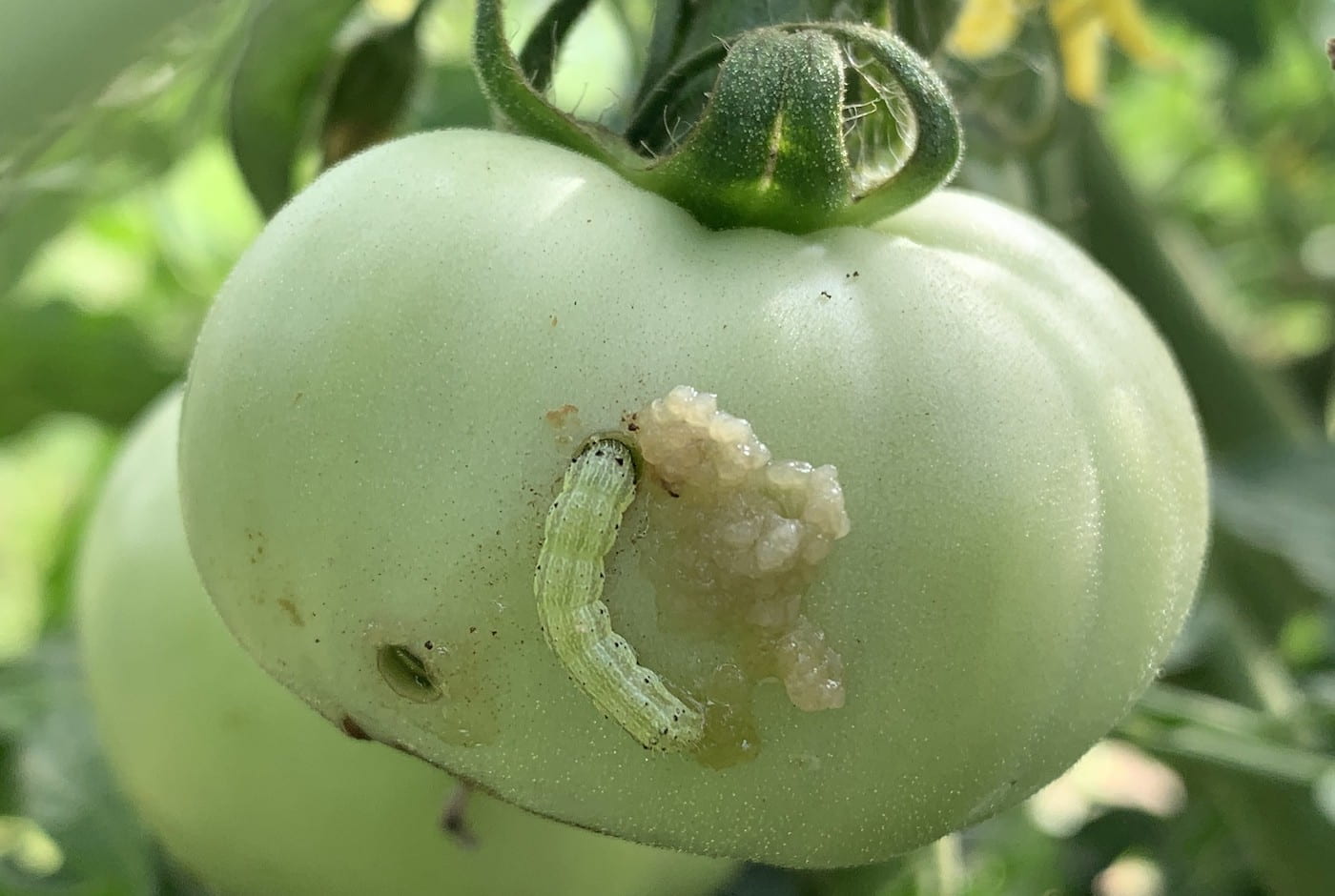Study on Pyrethroid Resistance in Tomato Fruitworm Develops New Recommendations

The Problem
The tomato fruitworm, the caterpillar of the Helicoverpa zea moth, has become resistant in Arkansas to insecticides containing pyrethroids as the active ingredient. Resistance has built up over decades of use in Arkansas but is less common in other states, likely because the moths come from a different source. The “H. zea” moths that migrate to Arkansas in the spring to lay their eggs are usually from Texas and Louisiana but do not stay for the winter in Arkansas.
Pyrethroids are synthetic forms of pyrethrin, the insecticide derived from the extract of chrysanthemum flowers. Pyrethroids inhibit the nervous system of insects at the sodium ion channels in the nerve cell membrane. They can also impact beneficial predatory insects. Commonly used pyrethroids contain active ingredients such as bifenthin, lambda-cyhalothorin, and esfenvalerate.
A two-year study by the Arkansas Agricultural Experiment Station has developed new recommendations to control the fruit-boring caterpillar of the Helicoverpa zea moth, also known as the tomato fruit worm. (UA System Division of Agriculture photo by Aaron Cato)
The Work
Aaron Cato, an extension specialist focusing on horticulture IPM for the University of Arkansas System Division of Agriculture Cooperative Extension Service and a researcher for the Arkansas Agricultural Experiment Station, conducted a study at the Southwest Research and Extension Center near Hope using diamides with the active ingredients chlorantraniliprole or cyantraniliprole as an alternative to pyrethroids.
Diamides selectively act on the intracellular calcium channels that play a central role in caterpillars’ muscle and nerve functions. They have the added benefit of being less active on the beneficial predatory insects that help control spider mites and aphids, Cato said.
A previous study by Virginia Tech University over 10 years ago developed the recommendation of spraying pyrethroids once growers found at least one egg per 10 plants or when 3 out of 100 fruit were infested. The Arkansas researchers used that threshold to determine pyrethroid effectiveness with current resistance issues, and to determine if it is a good threshold for the diamide products.
Resistance to pyrethroid pesticides has been developed by the tomato fruit worm in Arkansas, which lays small white eggs on the tomato plant’s leaves. Growers in Arkansas are advised to spray a diamide insecticide for better control once one egg per 10 plants is observed. (UA System Division of Agriculture photo by Aaron Cato)
The Results
Cato found that applications of diamide insecticides with the active ingredients chlorantraniliprole or cyantraniliprole could provide significantly better protection in Arkansas than pyrethroid insecticides.
In the test plots sprayed either weekly or on threshold with a pyrethroid containing the active ingredient lambda-cyhalothrin, researchers found damage to about 5 percent of the tomatoes. Plots sprayed only one time with a diamide containing the active ingredient chlorantraniliprole saw damage to about 1.5 percent of the tomatoes. He noted that the economic threshold is 3 percent damage to fruit.
As part of the study, Cato also confirmed the importance of being on the lookout for tomato fruitworm eggs and spraying at the threshold of one egg per 10 tomato plants. The study showed one pyrethroid application at that threshold offered the same protection as six straight weekly sprayings of a pyrethroid pesticide.
The 2020 and 2021 tests showed the diamides offered tomatoes protection for at least 21 days. So, some crops may need a second application, Cato said. He said that tomatoes should be scouted at least weekly to indicate when additional applications would be necessary.
Cato said pyrethroids may still be needed for other insects like stinkbugs since the diamides only kill caterpillars in this case. And although they were not looking to study foliage eaters like yellow-striped armyworms, they found the diamide products similarly controlled those caterpillars. These species are often found in row crops but more commonly in specialty crops like tomatoes and hops.
The Value
The study also indicated that there was no difference between spraying pyrethroid insecticides weekly versus at the one-egg-per-10-plant threshold, so growers may be able to reduce costs by reducing number of applications.
Based on the most recent Census of Agriculture, Arkansas ranks 15th in acres of tomatoes harvested in the U.S. with 952 acres harvested in 2017 (Arkansas Agriculture Profile 2021).
Funding
Amanda McWhirt, assistant professor and extension horticulture production specialist, was a partner in the study with support from the Southern Sustainable Agriculture Research and Education, a U.S. Department of Agriculture National Institute of Food and Agriculture grants and outreach program.
About the Researchers

Aaron Cato
Extension specialist in Horticulture Integrated Pest Management for the University of Arkansas System Division of Agriculture – Cooperative Extension Service
B.S. in Biological Sciences from Arkansas State University, Jonesboro, 2013
M.S. in Entomology from Kansas State University, Manhattan, Kansas, 2015
Ph.D. in Entomology from University of Arkansas, Fayetteville, 2018
Post-Doctoral Extension Entomology Fellowship at Auburn University, 2019
Aaron Cato is an extension specialist focusing on horticulture IPM for the University of Arkansas System Division of Agriculture Cooperative Extension Service and a researcher for the Arkansas Agricultural Experiment Station. His research focuses on sustainable management of pests (insects, pathogens, and weeds) in fruit and vegetable crops by employing systems approaches that rely on pest prevention and cultural controls, scouting, economic thresholds, and use of targeted and specific pesticide applications.

